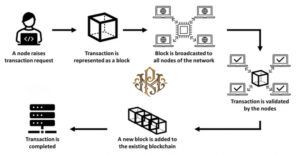
Close



In the field of blockchain technology, transactions are the fundamental building blocks that enable the secure and transparent transfer of assets between participants. Understanding how transactions are made is essential to understanding the basic principles of blockchain. In this article, we will examine what a transaction is in the context of blockchain, its components and the steps involved.
A blockchain transaction refers to the transfer of digital assets (cryptocurrencies, tokens, or data) from one participant to another in a secure, decentralized network. Transactions are recorded in blocks and linked together in a time chain and form a block chain.

Every transaction in the blockchain has a sender or originator whose digital wallet address initiates the transfer.
The recipient’s wallet address specifies the destination of the assets being transferred.
A specified amount of digital assets sent from a sender to a receiver.
In many blockchain networks, participants are required to pay a transaction fee to encourage network validators (miners or validators) to include their transaction in the next block.
Cryptographic signatures are used to ensure the security and authenticity of transactions. The sender signs the transaction with his private key, and the receiver can verify its authenticity using the sender’s public key.
The process starts when a participant decides to send digital assets. They create a transaction by specifying the address of the recipient, the amount to be transferred and other necessary details.
The transaction is broadcast to the network, where it is verified by nodes or miners. Validations check whether the sender has sufficient funds and whether the transaction adheres to network rules.
Valid transactions are collected by miners in a block. The block is then added to the blockchain through a consensus mechanism, ensuring agreement among network participants.
When a block containing a transaction is added to the blockchain, the transaction is considered confirmed. The number of confirmations may vary depending on the blockchain network, and each confirmation adds an additional layer of security.

The consensus mechanism plays an important role in determining which participant can add the next block to the blockchain. Proof-of-Work (PoW) and Proof-of-Stake (PoS) are common consensus mechanisms used to achieve consensus in decentralized networks.
When transacting on the blockchain, finality refers to the irreversible confirmation of a transaction. Once a transaction is added to the blockchain and has enough confirmations, it is considered final and cannot be reversed.
Blockchain transactions form the backbone of blockchain technology and enable the safe and transparent transfer of digital assets in a decentralized environment. Cryptographic principles, consensus mechanisms, and the sequential recording of transactions in blocks contribute to the robustness and reliability of blockchain networks. As blockchain technology continues to evolve, understanding the complexities of transactions is essential for anyone looking to navigate the rapidly expanding landscape of decentralized systems.